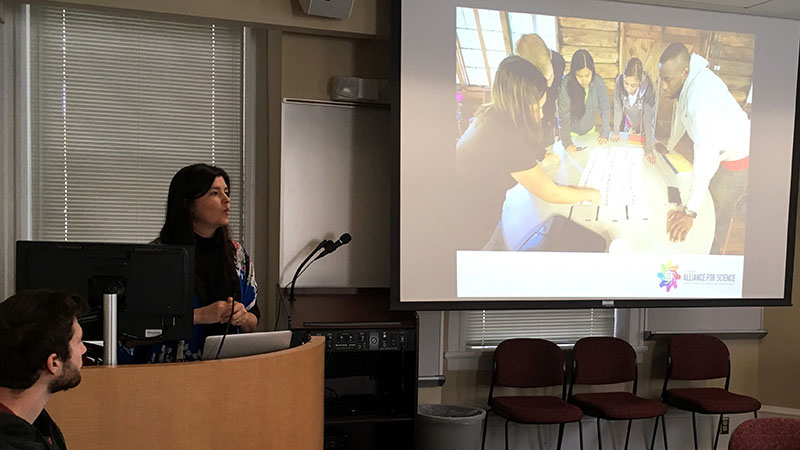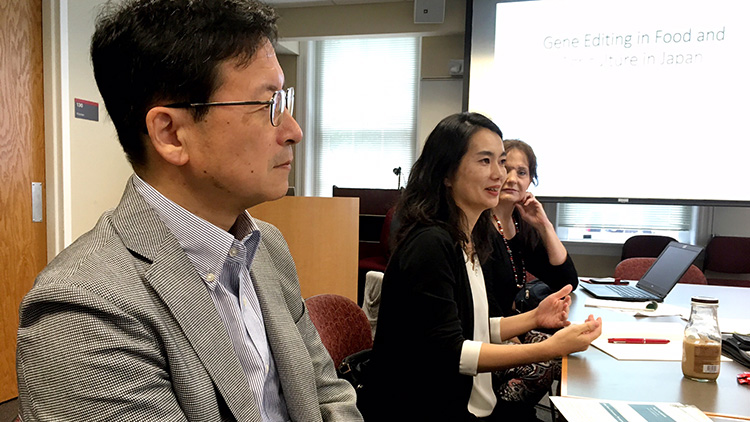Tuesdays at 12pm | 1911 Building, room 129
Colloquium Information
- YouTube Live Streams
- GES Colloquium meets weekly on Tuesdays at 12pm in the 1911 Building, Room 129. Add to calendar
- The Discussion Group meets on Thursdays at 12pm in 2321 Gardner Hall. Add to calendar
Colloquium speakers are asked to complete this form at least two weeks in advance of their scheduled talk: go.ncsu.edu/ges-speaker-prep
Please contact Dr. Jason Delborne with any questions.
Spring 2018 |
|---|
 Mike Jones, GES PhD Student: Surveying U.S. Public Opinion on Gene Drives for Agricultural Pests Date: 1/16/2018 | {video embargoed} ABSTRACT: A major proposed application for gene drives is to control agricultural insect pests which cause damage and spread crop disease. However, despite calls for upstream public engagement from scholars and funders of gene drive research, we still know little about how the public would react to such releases.Read more>> |
 Magda Stawkowski, Anthropology Postdoc: "I am a mutant." Date: 1/23/2018 | {video embargoed} ABSTRACT: “Mutant Biologies: Survival and Health Strategies at Kazakhstan’s Semipalatinsk Nuclear Test Site” The Soviet-era Semipalatinsk nuclear test site situated in contemporary Kazakhstan was an experimental landscape where science, technology, Cold War militarism, and human biology intersected to create lasting effects/legacies. Read more >> |
Larisa Rudenko, MIT Visiting Scholar: Goldilocks and the Regulatory Bears Date: 1/30/2018 ABSTRACT: Biotechnologies have been “emerging” since the 1980s. Their governance and regulation have been the subject of intense scrutiny. That technologies and the products resulting from them precede regulatory processes specific to them is neither novel nor unexpected. Read more>> |
Adam Kokotovich, GES Postdoc: Wild Rice, Genetic Engineering, & the Ojibwe: The Science of Responsible “Non-innovation” Date 2/6/2018 ABSTRACT: Given the growing power of gene editing, the importance of responsible research and innovation (RRI) is more apparent than ever. Yet within this area of work there is a need for further attention to when and how RRI should - at times - lead to “non-innovation.” Read more>> |
Caroline Ridley, EPA Ecologist: Gene Drive Organisms: An Ecological Risk Problem Date: 2/13/2018 ABSTRACT: Gene drive organisms represent the latest technology with the potential to address some of the most challenging pest-related problems in agriculture, public health, and conservation. Their proposed applications range from suppressing populations of damaging crop pests, to replacing disease-carrying mosquitoes with harmless variants, to eliminating populations of destructive island predators. In this talk, Dr. Caroline Ridley will share insights into current assessment approaches for evaluating the ecological risks of pest control products, and discuss how novel aspects of gene drive organisms may spur the need for innovative assessment approaches. |
|
|
|
|
|
|
| Jesse Tack, Associate Professor of Agricultural Economics, Kansas State University: The Interconnected Impacts of GE and Weather on Corn Yields Date: 4/10/18 ABSTRACT: Concern about declining growth in crop yields has renewed debates about the ability of biotechnology to promote food security. While numerous experimental and farm-level studies have found that adoption of genetically engineered crops has been associated with yield gains, aggregate and cross-country comparisons often seem to show little effect, raising questions about the size and generalizability of the effect. This paper attempts to resolve this conundrum using a panel of United States county-level corn yields from 1980 to 2015 in conjunction with data on adoption of genetically engineered crops, weather, and soil characteristics. Read more>> |
|
Andy Newhouse, PhD Student at the SUNY College of Environmental Science & Forestry: Transgenic American Chestnuts for Potential Forest Restoration: Scientific Successes, Regulatory Challenges Date: 4/24/18 | View Slides ABSTRACT: The American chestnut was once an integral part of eastern US deciduous forests, with many environmental, economic, and social values. This ended with the introduction of an invasive fungal pathogen causing chestnut blight, which wiped out over three billion trees across their native range. Transgenic American chestnuts expressing a wheat gene for oxalate oxidase (OxO) successfully tolerate blight infections. The OxO enzyme breaks down oxalic acid, a toxin produced by the blight fungus, but it does not harm the fungus itself. Restoring American chestnuts to their native environments could benefit people and ecosystems, but transgenic forest trees have not been previously released or extensively studied in the US. Read More > |
Fall 2017 |
|---|
 Sarah Evanega, Cornell Alliance for Science: Empowering Champions, Embracing Advocacy Date: 11/14/2017 ABSTRACT: Solutions to hunger, poverty, and sustainable agricultural growth are often inaccessible to Less Developed Countries (LDCs), where they are needed the most. Public Lecture - "Hunger & Hypocrisy: A Climate for GMO Change," Monday, 11/13/2017 |
Eli Hornstein, PhD Student: Re-Engineering A Lost Symbiosis Date: 11/7/2017 | Request password ABSTRACT: Biotechnology has great potential as a tool to address pressing issues beyond the agricultural applications in wide use today. In the context of environmental conservation, Eli will discuss how biotechnology could provide solutions to problems that have been intractable to traditional approaches for decades. |
Tom Wedegaertner, Cotton, Inc.: Ultra-Low Gossypol Cottonseed Date: 10/31/2017 | Request password ABSTRACT: Many plants use chemical defense mechanisms to reduce or eliminate predation and the cotton plant is no exception. Gossypol, a naturally occurring noxious compound, found in pigment glands located throughout the cotton plant, is an effective insect deterrent and a cumulative toxin in animals. The elimination of gossypol allows cottonseed protein to be used much more efficiently by using it in food products for direct consumption by humans, rather than feeding it to inefficient cattle. |
Rene Valdez, PhD Student: Perceptions of De-extinction Among Experts and in the News Media Date: 10/24/2017 ABSTRACT: De-extinction is the re-creation of extinct species using methods from synthetic biology, cloning, genetic engineering, reproduction technologies, and stem cell research. Researchers around the world are investigating the possibility of reviving species, including the woolly mammoth, passenger pigeon, and gastric-brooding frog. These efforts have drawn considerable attention from scholars and the media. |
Keith Edmisten, NC State: The Adoption of Biotech in Cotton Production Download slides on SlideShare Date: 10/17/2017 ABSTRACT: Cotton producers - both in North Carolina and across the U.S. - were early adopters of biotech. The cotton industry has widely employed the use of insect resistant and herbicide tolerant varieties, evolving the variety of traits and management strategies along the way. Producers have experienced both pros and cons in this evolution. |
Steven Druker, Alliance for Bio-Integrity and author of Altered Genes, Twisted Truth: Genetic Engineering and the Chronic Misrepresentation of Facts Date: 10/10/2017 ABSTRACT: Although bioethicists have addressed a wide range of issues posed by recombinant DNA technology and its unprecedented power to alter genomes, they have overlooked the most crucial one: that the venture to employ this genetic engineering technology in food production has been chronically dependent on misrepresentation. |
David Berube, NC State: ZIKA Date: 10/3/17 ABSTRACT: Dr. Berube, who is working on a book entitled Communicating Zika, gives a student-directed conversation on the subject. Topics include how Zika got into Brazil, why it's so dangerous (the microcephaly connection), what the future may hold, how it is being mitigated and the roles of government and media. |
Dan Charles, Author and NPR Correspondent: Genetic Engineering & Journalism Date: 9/26/2017 ABSTRACT: Discussion about some of the different ways that journalists have covered genetic engineering over the past several decades, and the journalistic conventions and impulses that shape this coverage.AGES: Untold Stories of GMO Pioneers Keynote, 9/26/2017 |
Jayce Sudweeks, PhD Student: Examining the Policy Narratives Surrounding the Release of GM Mosquitoes Date: 9/19/2017 | Request password ABSTRACT: In an effort to combat diseases such as dengue fever and Zika, genetically modified (GM) mosquitoes have been released in Brazil to control mosquito populations. A similar release effort was attempted in the Florida Keys, but has been delayed. |
 Dr. Makiko Matsuo & Dr. Masashi Tachikawa: Gene Editing and Agriculture in Japan Date: 11/14/2017 [This colloquium was not recorded at the request of our speakers] ABSTRACT: Dr. Makiko Matsuo and Dr. Masashi Tachikawa, traveled from Japan to discuss their research around the ethical, legal and social implications (ELSI) related to gene editing in the food and agriculture sectors. Currently in the second year of a five year project, Drs. Matsuo and Tachikawa visited NC to explore the types of research and development projects are occurring (e.g. crops, livestock, fish), legal/regulatory issues, and public engagement around and acceptance of GMO technologies. |
Michael Vella & Sumit Dhole, PhD Students: Population Genetics of Gene Drives Date: 9/5/2017 ABSTRACT: Michael Vella discusses theoretical analysis of gene drive countermeasures that could be used to reverse a CRISPR-based homing drive. Countermeasures include synthetic resistance alleles, reversal drives, and immunizing reversal drives.Related Publications: |
Todd Kuiken, GES Center: The Long & Winding Road: Synthetic Biology and the U.N. Convention on Biological Diversity Date: 8/29/2017 ABSTRACT: There are multiple processes happening inside the United Nations in relation to synthetic biology and the shift towards digital genomic information both simultaneously and separately. Within the Convention on Biological Diversity, the Secretariat implemented a process to continue the work of an Ad-Hoc Technical Expert group that is charged with understanding the impacts of synthetic biology as it relates to the Convention. |
Fall 2017 GES Colloquium Intros Date: 8/22/17 |
Discussion Section
Do you ever leave on Tuesdays wishing you could dig a little deeper into the research you just heard about? We feel the same way. The GES Discussion Section (GES 591-002, 1 credit) meets on Thursdays from 12-1 in 2321 Gardner Hall to further discuss that week’s topic plus a reading. Sessions are informal and experimental. Faculty are also encouraged to attend whenever you’re available. Please contact Dr. Jason Delborne with questions.
VIDEOS | Quick Links
- Andy Newhouse, PhD Student, SUNY College of Environmental Science and Forestry: Transgenic American chestnuts for potential forest restoration: scientific successes, regulatory challenges, 4/24/18
- Bruce Tabashnik, CALS, University of Arizona: Challenges of Trying to Be an Honest Broker on Insect Resistance to GE Crops, 4/17/18
- Jesse Tack, Associate Professor of Agricultural Economics, Kansas State University: The Interconnected Impacts of GE and Weather on Corn Yields, 4/10/18
- Elliott Montgomery, Assistant Professor of Strategic Design at Parsons School of Design, and Co-founder of The Extrapolation Factory: Futures Studies and Speculative Design, 4/3/18
- Katie Barnhill-Dilling, PhD Student, Forestry and Environmental Resources: Surprise, ethics, and more surprise: Collaborative research, indigenous communities, and the transgenic American chestnut, 3/27/18 Request password
- David Hawthorne, Professor of Entomology, University of Maryland and Director of Education, SESYNC: Socio-Environmental Synthesis: Opportunities for advancement of genetic technologies?, 3/20/18
- Nora Haenn, Professor, Anthropology Graduate Program: Multiple Roles to Affect Change: Lobbyists, Thought Leaders, Public Intellectuals, and Others, 3/13/18 Request password
- Megan Serr, PhD Student: Male house mouse competition in semi-natural environments, 2/27/18
- Royden Saah, Island Conservation Project Manager: GBIRd Program Update, 2/20/18
- Caroline Ridley, EPA Ecologist: Gene Drives and Ecological Risk, 2/13/2018
- Adam Kokotovich, GES Postdoc: Wild Rice, Genetic Engineering, & the Ojibwe: The Science of Responsible “Non-innovation,” 2/6/2018
- Larisa Rudenko, MIT Visiting Scholar: Goldilocks and the Regulatory Bears, 1/30/2018
- Eli Hornstein, PhD Student: Re-Engineering A Lost Symbiosis, 11/7/2017 Request password
- Tom Wedegaertner, Cotton, Inc.: Ultra-Low Gossypol Cottonseed, 10/31/2017 Request password
- Rene Valdez, PhD Student: Perceptions of De-extinction, 10/24/2017
- Keith Edmisten, NC State: The Adoption of Biotech in Cotton Production, 10/17/2017
- Steven Druker, Alliance for Bio-Integrity: GE & the Chronic Misrepresentation of Facts, 10/10/2017
- David Berube, NC State: ZIKA, 10/3/17
- Dan Charles, NPR: Genetic Engineering & Journalism, 9/26/2017
- Jayce Sudweeks, PhD Student: Policy Narratives Surrounding the Release of GM Mosquitoes, 9/19/2017 Request password
- Michael Vella & Sumit Dhole, PhD Students: Population Genetics of Gene Drives, 9/5/2017
- Todd Kuiken, GES Center: SynBio & the U.N. Convention on Biological Diversity, 8/29/2017
- Fall 2017 GES Colloquium Intros, 8/22/17
